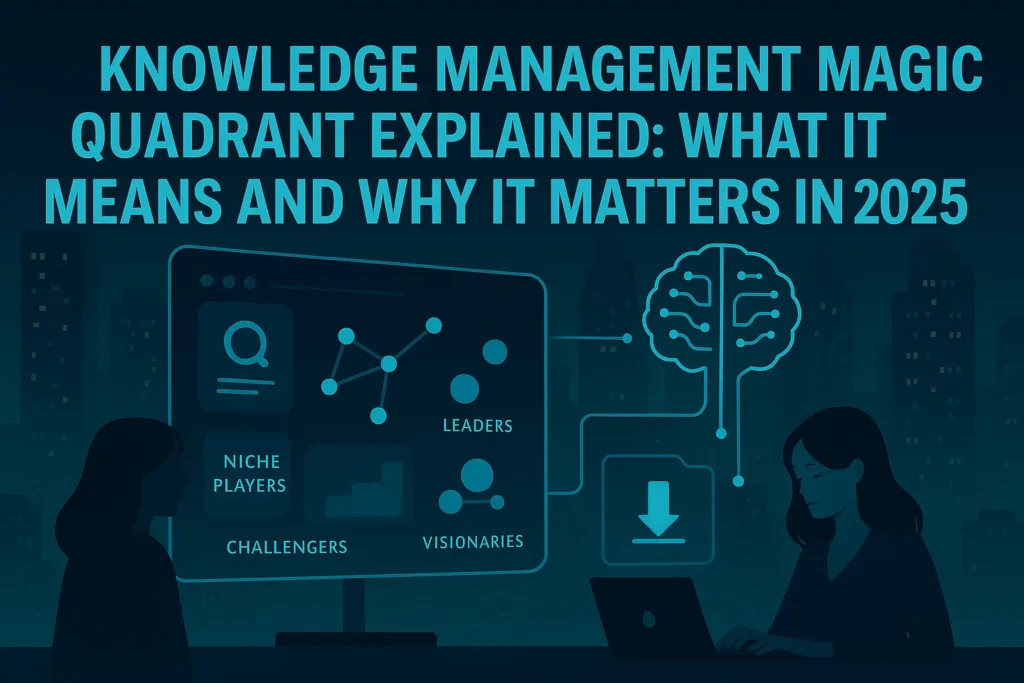The enterprise landscape is rapidly evolving, and so is the need for intelligent, scalable knowledge management solutions. With hundreds of platforms on the market, decision-makers are looking for credible frameworks to guide software selection. One of the most authoritative among them is Gartner’s Knowledge Management Magic Quadrant.
This article breaks down what the Magic Quadrant is, how it applies to knowledge management (KM), who the key players are in 2025, and how business leaders can interpret its findings to make better strategic decisions.

Knowledge Management Magic Quadrant
What Is the Magic Quadrant?
The Magic Quadrant (MQ) is a proprietary market research methodology developed by Gartner, a global leader in IT and business consulting. Each MQ assesses technology vendors in a specific category, based on two critical dimensions:
- Ability to Execute — This measures a vendor’s product maturity, customer support, financial health, and operational excellence.
- Completeness of Vision — This assesses innovation, strategic direction, understanding of market trends, and ability to anticipate future needs.
The result is a 2×2 matrix that places vendors in one of four quadrants:
- Leaders: Strong execution and a forward-thinking vision
- Challengers: Strong execution but weaker in innovation or long-term strategy
- Visionaries: Innovative, but may lack maturity or global scale
- Niche Players: Often specialized or emerging providers with limited execution
Each quadrant gives decision-makers a clear picture of how solutions compare in the current landscape.
Is There a Magic Quadrant for Knowledge Management?
Gartner has historically evaluated knowledge management platforms within the context of Customer Service Knowledge Management (CSKM) or related categories like Enterprise Search, Digital Workplace, and Conversational Platforms. While a standalone KM Magic Quadrant isn’t always published annually, KM vendors are often assessed in:
- Magic Quadrant for Customer Service Knowledge Management
- Magic Quadrant for Enterprise Search (retired but previously influential)
- Magic Quadrant for Digital Experience Platforms
- Magic Quadrant for Content Services Platforms
In 2025, knowledge management is increasingly being evaluated within the customer experience and digital transformation ecosystems, often blended with AI, automation, and employee enablement tools.
Why the Magic Quadrant Matters for KM Buyers
Whether you’re a CIO, KM Director, or IT strategist, the Magic Quadrant helps:
- Validate Vendor Claims: Gartner’s independent research offers a level of credibility beyond vendor marketing.
- Shortlist Candidates: Instead of evaluating 50+ vendors, focus on the top performers in the quadrant.
- Assess Market Trends: MQ reports often include emerging trends, technology shifts, and critical capabilities.
- Justify Budget Decisions: A Gartner-backed report can support internal business cases or board-level discussions.
For organizations investing in AI-powered KM, the quadrant also reveals how each vendor is leveraging artificial intelligence, natural language search, automation, and analytics.
Common KM Platforms Found in the Quadrant (2025)
While the official list is proprietary and subject to change, these vendors are frequently featured across KM-related quadrants or cited in Gartner Peer Insights:
ServiceNow
Enterprise-grade KM platform with integrated virtual agents, AI search, and process automation. Dominant in IT service management and digital workflows.
Salesforce Knowledge
Part of the Salesforce Service Cloud suite. Offers AI-assisted article suggestions, in-context answers, and customer-facing help centers.
Zendesk
Known for support-centric KM. AI bots, guided workflows, and a simple content publishing interface make it ideal for customer service teams.
Microsoft Viva Topics / SharePoint Syntex
Microsoft’s KM layer within its M365 ecosystem. Uses AI to auto-organize content, build topic pages, and surface relevant info across Teams and SharePoint.
Verint Knowledge Management
Tailored for customer service operations with a focus on compliance, multilingual content, and intelligent response automation.
Atlassian Confluence (Enterprise)
Popular for internal knowledge hubs, especially among product and engineering teams. Integrates with Jira and now features AI plugins.
BMC Helix Knowledge Management
Designed for IT service desks. Strong in automation, change management, and structured KM processes.
Bloomfire
Frequently praised for usability and AI-powered search. Visual knowledge sharing and analytics make it a favorite among mid-sized enterprises.
Understanding Placement in the Quadrant
- Leaders: Offer both strong current capabilities and a roadmap for innovation. Example: ServiceNow, Salesforce.
- Challengers: Execute well in specific use cases but may lack AI innovation or market breadth. Example: BMC.
- Visionaries: Disruptive platforms experimenting with AI, ML, or new delivery models. May lack proven enterprise scale. Example: Bloomfire, Verint.
- Niche Players: Often serve a specific industry (e.g., healthcare, retail) or function (e.g., legal KM).
No quadrant is inherently bad—it depends on your organization’s needs, size, and digital maturity.
Tips for Using the MQ in KM Platform Selection
- Download the Full Report: If available, read the vendor comparison table and detailed notes.
- Use It as a Starting Point: MQs are excellent for shortlisting but should be complemented by demos, trials, and reference checks.
- Consider Your Use Case: Some platforms are better for customer service KM; others excel in internal documentation or R&D knowledge.
- Don’t Ignore Niche Players: Emerging vendors may be more agile, cost-effective, and aligned with your specific sector.
- Map to Your Ecosystem: Ensure the KM platform integrates with your existing tools—like Slack, Teams, CRM, or ERP systems.
Final Thoughts
The Knowledge Management Magic Quadrant is more than just a matrix—it’s a strategic lens into the evolving KM technology landscape. In 2025, organizations that treat KM as a core capability, powered by AI and aligned with digital workflows, will outperform those stuck with static or siloed solutions.
Whether you’re selecting a new platform or reassessing your current stack, use the Magic Quadrant not as a verdict—but as a valuable input in a broader decision-making process.
👉 Related: Top AI-Powered Knowledge Management Software for 2025
Disclaimer: This article references publicly available insights and common inclusions in Gartner MQ reports. For exact vendor positioning, always refer to the official Gartner Magic Quadrant document or licensed access.
Subscribe to receive notifications for free webinars on Knowledge Management.
